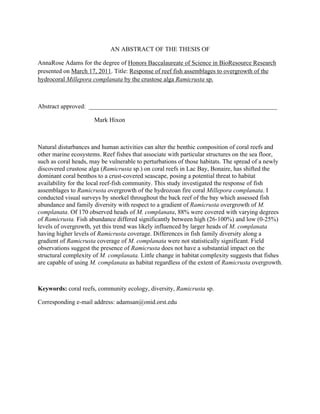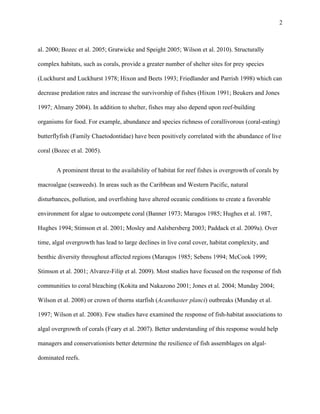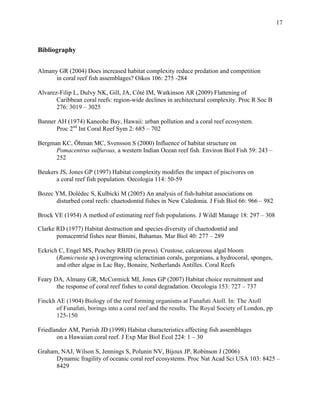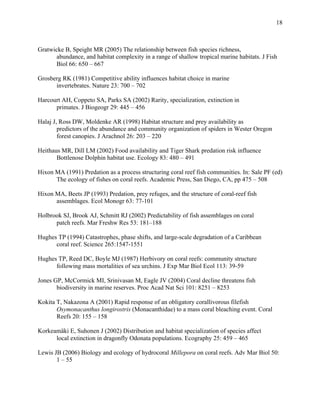This study investigated how the overgrowth of the hydrocoral Millepora complanata by the crustose alga Ramicrusta sp. impacted reef fish assemblages in Lac Bay, Bonaire. The author observed 170 M. complanata heads and found 88% were covered by Ramicrusta to varying degrees. Fish abundance was significantly higher on M. complanata with low (0-25%) Ramicrusta coverage compared to high (26-100%) coverage. However, fish diversity did not significantly differ along the Ramicrusta gradient. Additionally, larger M. complanata heads tended to have higher Ramicrusta coverage but similar structural complexity, suggesting fishes could


















![9
M. complanata was found to be maximally overgrown (76 – 100%) by Ramicrusta, and the
lowest proportion (15%) was observed within the no overgrowth category (Fig. 2).
Fig. 2 Frequency distribution of algal overgrowth categories for 170 heads of M. complanata.
Fish Abundance
Across the gradient of algal overgrowth, the abundance of fish increased from 0 to 75 %
Ramicrusta coverage (Fig. 3). At maximal overgrowth (76-100%), fish abundance declined to
values similar to those with no overgrowth (Fig. 3). Significant differences in abundance were
detectable among algal overgrowth categories (Kruskall-Wallis: χ
2
[4, n = 170] = 13.28, p=0.01).
Differences in the median abundance of fish were detected between 0 – 25% and 26% - 100%
Ramicrusta coverage (Mann-Whitney U-test: W=3007.5, two-sided p = 0.001). Coral heads 26 –
100% overgrown by Ramicrusta had 1 ± 1 (mean ± 95% CI) more fish present than coral heads 0
– 25% overgrown.](https://image.slidesharecdn.com/928bca2d-b785-458b-9c0b-f9b3236bb2bd-151223045908/85/AdamsAnnaRose2011_Thesis-19-320.jpg)

![11
Fish Diversity
Fish family richness, evenness, and composite diversity showed trends similar to fish
abundance. Mean values of all three measures generally increased from 0 to 75 % Ramicrusta
overgrowth, followed by a decline at maximal overgrowth (76-100%) (Fig. 3). Significant
differences in all three components of diversity were not detected among overgrowth categories
(Kruskall-Wallis: richness: χ
2
[4, n = 134] = 6.9, p=0.14; composite diversity: χ
2
[4, n = 134] =
5.9, p=0.21; evenness: χ
2
[4, n = 134] = 4.3, p=0.37).
Influence of Millepora complanata volume
Visual estimates of coral volume were positively correlated with fish abundance, but not
with fish diversity (Fig. 4). Abundance was moderately associated with the volume of M.
complanata (r=0.19, n=131, p <0.0001). While Pearson’s correlation coefficients detected a
positive relationship between fish diversity and volume, the correlations were not statistically
significant (richness: r=0.17, n=100, p= 0.094; composite diversity: r=0.15, n=100, p=0.14;
evenness: r=0.12, n=100, p=0.22).
Larger heads of M. complanata were observed more frequently at higher levels of
Ramicrusta overgrowth (Fig. 5). Mean coral volume was significantly different between
moderate to high levels of overgrowth (26-100 % Ramicrusta cover) and low levels of
overgrowth (0-25 % Ramicrusta cover) (Mann-Whitney U-test: W=962, two-sided p-value
<0.0001). M. complanata volume was estimated to be 58 ± 23 L (mean ± 95% CI) larger at 26-
100 % Ramicrusta overgrowth, than 0-25 % overgrowth. Increasing M. complanata volume was
also positively correlated with increasing Ramicrusta coverage (r=0.25, n=130, p=0.004).](https://image.slidesharecdn.com/928bca2d-b785-458b-9c0b-f9b3236bb2bd-151223045908/85/AdamsAnnaRose2011_Thesis-21-320.jpg)
![12
Fig. 4 Comparison of Ramicrusta overgrowth categories and estimated Millepora complanata
volume (mean + SEM). Mean M. complanata volume was significantly different between 0-25%
Ramicrusta overgrowth and 26-100% overgrowth at p<0.0001 (***).
Fish density was inversely associated with Ramicrusta overgrowth (Fig. 6). At coral
heads where Ramicrusta was not present, the greatest density of fish was observed (0.49 fish/L).
However, differences in fish density among algal overgrowth categories were not statistically
significant (Kruskall-Wallis: χ
2
[4, n = 130] = 1.67, p=0.80).
Fig. 5 Fish density (number of fish/L) with respect to Ramicrusta overgrowth categories.](https://image.slidesharecdn.com/928bca2d-b785-458b-9c0b-f9b3236bb2bd-151223045908/85/AdamsAnnaRose2011_Thesis-22-320.jpg)







![20
Pielou EC (1966) The measurement of diversity in different types of biological
collections. J Theoret Biol 13: 131 – 144
Pratchett MS, Wilson SK, Berumen ML, Mc
Cormick MI (2004) Sublethal effects of coral
bleaching on an obligate coral feeding butterflyfish. Coral Reefs 23: 352 – 356
Pratchett MS, Munday PL, Wilson SK, Graham NAJ, Cinner JE, Bellwood DR, Jones GP,
Polunin N, McClanahan T (2008) Effects of climate-induced coral bleaching on coral-
reef-fishes: ecological and economic consequences. Oceanogr Mar Biol Annu Rev 46:
251–296
Precht WF, Aronson RB, Moody RM, Kaufman L (2010) Changing patterns of
microhabitat utilization by the threespot damselfish, Stegastes planifrons, on Caribbean
reefs. PLoS ONE 5 [doi:10.1371/journal.pone.0010835]
Pueschel CM, Saunders GW (2009) Ramicrusta textilis sp. nov. (Peyssonneliaceae,
Rhodophyta), an anatomically complex Caribbean alga that overgrows corals. Phycologia
48: 480- 491
Rodríguez MA (1995) Habitat-specific estimates of competition in stream salmonids: a
field test of the isodar model of habitat selection. Evol Ecol 9: 169 – 184
Safi K, Kerth G (2004) A comparative analysis of specialization and extinction risk in
temperate-zone bats. Conserv Biol 18: 1293 – 1303
Sano M, Shimizu M, Nose Y (1984) Changes in structure of coral reef fish communities
by destruction of hermatypic corals: observational and experimental views. Pac Sci 38:
51 – 79
Sebens KP (1981) Recruitment in a sea anemone population: juvenile substrate becomes
adult prey. Science 213: 785 – 787
Sebens KP (1994) Biodiversity of coral reefs: what are we losing and why? Amer Zool
34: 115 – 133
Sih A (1982) Foraging strategies and the avoidance of predation by an aquatic insect,
Notonecta hofffmanni. Ecology 63: 786 – 796
Schroder GD, Rosenzweig ML (1975) Pertubation analysis of competition and overlap in
habitat utilization between Dipodomys ordii and Dipodomys merriami. Oecologia 19: 9 -
28
Sheppard CRC, Spalding M, Bradshaw C, Wilson S (2002) Erosion vs. recovery of coral
reefs after 1998 El Niño: Chagos Reefs, Indian Ocean. J Hum Environ 31: 40 – 48](https://image.slidesharecdn.com/928bca2d-b785-458b-9c0b-f9b3236bb2bd-151223045908/85/AdamsAnnaRose2011_Thesis-30-320.jpg)




